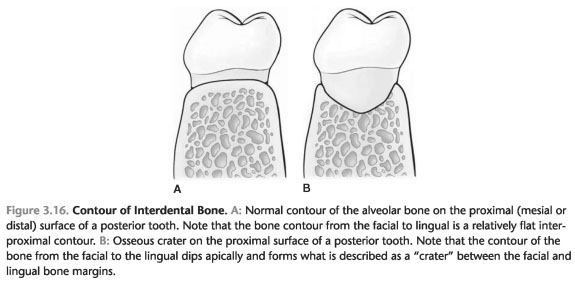Bone Defects in Periodontal Disease
Periodontal disease results in different types of defects in the alveolar bone. These
bone defects are called bone defects.
A. Infrabony Defects
1. Infrabony defects when bone resorption occurs unevenly, an oblique direction. In infrabony defects of bone resorption primarily affects one tooth.
2. Classification Infrabony defects. Infrabony defects are classified based on the number of bone wall. Infrabony defects can have one, two or three walls (Fig. 3-15).
B. Bone Craters. In bone crater bowl-shaped defect in interdental alveolar bone, bone loss is almost equal to the roots of the two adjacent teeth (Fig. 3-16A, B).
1. While infrabony defects primarily affects one tooth, craters, affects two adjacent surfaces roots to the same extent.
2. The presence of bone crater causes plaque biofilm to collect and makes it difficult to clean interdental areas.


C.
bone loss in areas fork
1. The split occurs on the multichannel tooth when periodontal infection penetrates into the area between and around the roots, which leads to the loss of
alveolar process between the roots of teeth.
2. Loss of bone mass in the split pane can be hidden under the gum tissue or may be clinically visible in the mouth (Fig. 3-17).
 ..
..